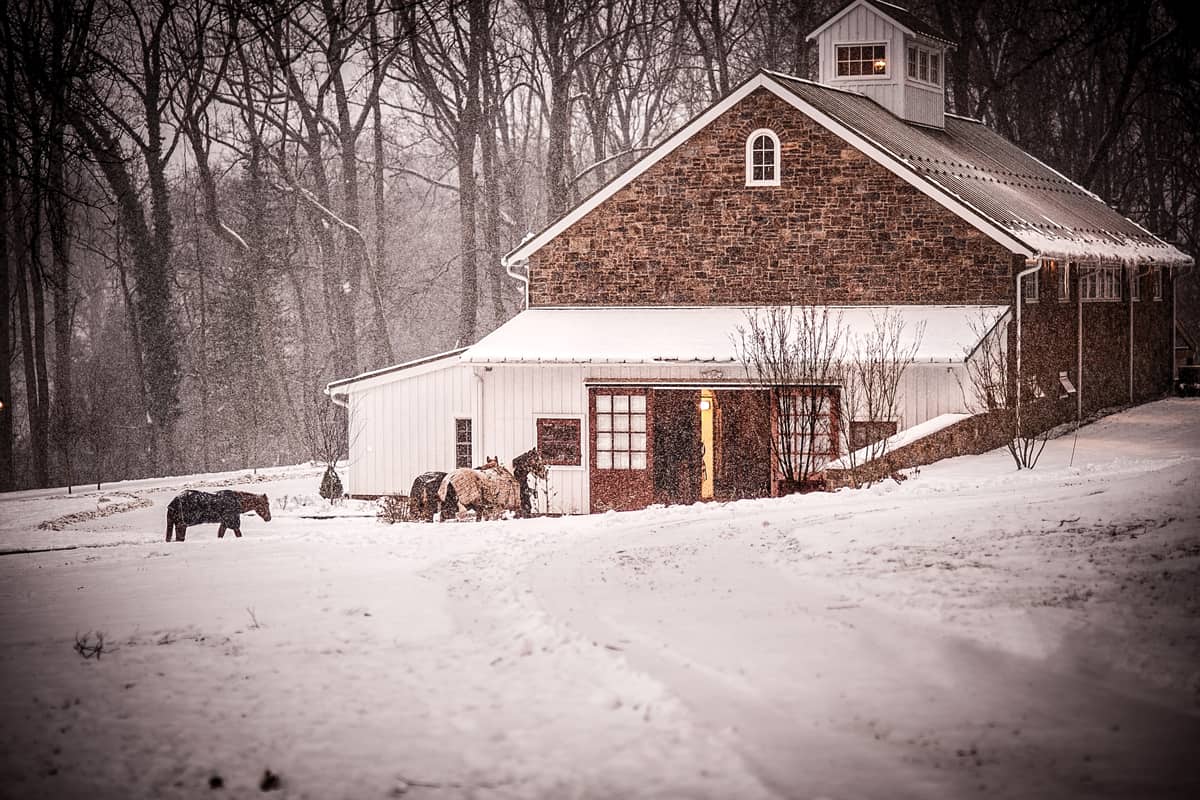Horses are resilient animals that handle cold weather surprisingly well. However, ensuring your barn and routine are ready for winter is crucial to keeping your horse healthy, comfortable, and safe when temperatures drop. Read on for a list of winter care tips to ensure a happy and healthy cold-weather season.
Check for Drafts
Good ventilation is critical for maintaining healthy air quality in your barn. Fresh air circulation helps to reduce ammonia buildup from urine and manure, keeping your horse’s respiratory system healthy and avoiding problems like thrush1. However, large drafts are a different story. Excessive cold air entering through gaps can create uncomfortable and even harmful conditions for your horses.
- Inspect Windows and Doors: Examine the barn and check for loose or damaged windowpanes, broken hinges, and worn-out seals. Replace any broken glass and seal gaps with weather-resistant caulking or foam.
- Address Holes: Look for holes or cracks in walls, especially in older barns. Use wood filler or sturdy patching material to block drafts while retaining airflow through proper ventilation.
- Monitor High-Traffic Areas: Barn entrances and exterior stall doors are common culprits for drafts. Consider using heavy-duty vinyl strip door curtains or weather stripping to reduce air seepage while keeping doors functional.
Evaluate Your Barn Doors
Quality barn doors are more than just an aesthetic feature — they’re vital for providing adequate protection from the elements. Gaps or poorly fitted doors can compromise your horse’s comfort and dramatically increase heating costs.
- Examine End Doors: Check the fit of your barn’s end doors. They should close snugly from side to side and top to bottom. Large gaps can let in cold air, snow, and rodents looking for a warm place to shelter.
- Upgrade When Needed: If your barn doors are warped, damaged, or no longer fit properly, investing in custom-built replacements is a wise choice. Sliding or Dutch-style doors with weatherproofing can be both functional and visually appealing.
- Maintain Regularly: Lubricate tracks, hinges, and locks to ensure smooth operation during icy conditions. Faulty door latches should be replaced to keep the barn secure against winter storms.
Maintain a Reliable Water Supply
Water is essential for horse health, even in winter when dehydration might seem less of a concern. Frozen water troughs or buckets can prevent your horse from drinking enough, leading to serious health issues like colic. Additionally, a horse can lose 4% of its body weight after only 24 hours of dehydration, and 9% after 72 hours2.
- Invest in Heated Waterers: A heated water trough or bucket prevents freezing and encourages horses to drink regularly, even on the coldest days. A water temp between 40-75º F is ideal.
- Monitor Water Consumption: Horses typically drink between 5-10 gallons of water a day. Keep an eye on their intake and refill water sources frequently to avoid running out. Signs of low water intake include dry mucous membranes, sunken eyes, and often reduced feed intake.
- Don’t Rely on Snow: While horses can eat snow in small amounts, it’s not a sufficient source of hydration. Consuming large quantities of snow to meet water needs can cause your horse’s body temperature to drop, increasing the risk of hypothermia.
Keep Riding Throughout the Winter
Maintaining a regular exercise routine is essential for your horse’s physical and mental health, even in winter. However, frozen ground and cold weather present unique challenges.
- Indoor Arenas: If you have access to a heated indoor arena, this is the ideal way to continue riding during the winter season, avoiding icy surfaces and extreme weather.
- Outdoor Riding Tips: For outdoor rides, prepare a safe track in your pasture or field. Use shavings, sand, or other footing materials to soften frozen ground and reduce the risk of slips or injuries.
- Warm-Up and Cool-Down: Take extra time to warm up your horse before riding and to cool them down afterward. This helps to prevent stiff muscles and ensures a smooth transition back to the barn’s colder environment.
- Check Tack Fit: Winter blankets and thicker coats can affect how saddles and bridles fit. Adjust tack as needed to ensure comfort and prevent chafing.
Keep the Barn Clean & Organized
Winter can bring extra challenges in maintaining barn cleanliness, but a clean barn is essential for horse health.
- Remove Manure Daily: Regular mucking reduces moisture and ammonia buildup, keeping stalls dry and pest- and odor-free.
- Organize Supplies: Stock up on feed (a two-week supply is recommended), bedding, and first aid supplies before winter storms hit. Keep items neatly stored in a dry, rodent-proof area for easy access.
- Prevent Ice Hazards: Clear snow and ice from pathways, doorways, and feeding areas. Use barn-safe salt or sand to prevent slipping risks.
Prepare for Emergencies
Winter weather can be unpredictable, so it’s important to have a plan in place for emergencies like power outages or severe storms.
- Backup Power: Invest in a reliable generator to power essential systems like lighting, water heaters, and ventilation.
- Stockpile Essentials: Keep an extra supply of hay, bedding, and water stored in case roads become impassable.
- First Aid Kit: Update your equine first aid kit with winter-specific items such as blankets, hoof warmers, and ointments for chapped skin or frostbite.
Weathering Winter
By taking the time to prepare your barn and implement thoughtful care practices, you’ll ensure that your horses stay comfortable, hydrated, and safe throughout the winter months. Whether it’s upgrading barn doors, keeping water troughs ice-free, or creating safe riding conditions, these steps are key to successful winter horse care. For more information on keeping your barn winter-ready or are considering an upgrade, contact the experts at B&D Builders.
